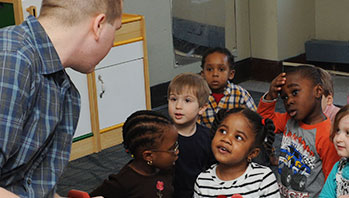- pictures of healthy plants: in the sun, being rained on, blowing in wind, etc.
- bark
- ground
- leaves
- plant
- sunlight
MA Standards:
Speaking and Listening/SL.PK.MA.1: Participate in collaborative conversations with diverse partners during daily routines and play.
Language/L.PK.MA.1: Demonstrate use of oral language in informal everyday activities.
Language/L.PK.MA.5: With guidance and support from adults, explore world relationships and nuances of word meanings.
Language/L.PK.MA.6: Use words and phrases acquired through conversations, listening to books read aloud, activities, and play.
MA Draft Standards
Life Sciences/Ecosystems; Biological Evolution/LS2/4.B: Using their experiences in the local environment and other evidence, raise and discuss questions about the basic needs of familiar organisms and how they might meet their needs. (Clarification statement: basic needs include water, food, air, shelter, and light for most plants)
Head Start Outcomes
Language Development/Receptive Language: Attends to language during conversations, songs, stories, or other learning experiences.
Language Development/Expressive Language: Uses language to express ideas and needs.
PreK Learning Guidelines:
English Language Arts/Language 2: Participate actively in discussions, listen to the ideas of others, and ask and answer relevant questions.
Science and Technology/Life Sciences 10 :Observe and identify the characteristics and needs of living things: humans, animals, and plants.
Talk Together: More About Plants

© Commonwealth of Massachusetts, Department of Early Education and Care (Jennifer Waddell photographer). All rights reserved.
STEM Key Concepts: Plants need water, food, and sunlight to grow; Plants grow in places where they get their needs met; Plants often grow in some type of dirt
ELA Focus Skills: Speaking and Listening, Vocabulary
Ask children to share the picture of a plant they saw on their way home yesterday. Encourage them to describe the plant’s color, size, texture, or shape. Display their pictures of plants.
Talk about plants. Discuss how all living things have certain needs. Help children understand the difference between needs and wants by asking questions such as, Do you need <a bike> in order to live or do you want <a bike>? Do you need food? Talk about the difference between things you “need” and things you “want.” Ask children,
- What is something you think you need in order to live? (water, food, air)
- What kinds of things do you think plants need in order to live? (water, food, air, some sunlight)
Educator Tip: Plants need food but, unlike animals, they make their own food through the process of photosynthesis. This concept is much too complex for this age; focus instead on helping children investigate what they can through observation and the idea that all living things have needs.
